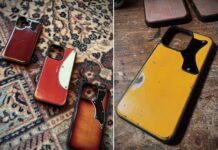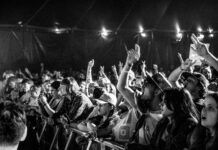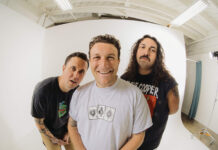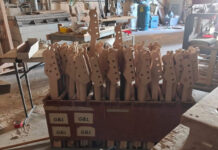
The Story Of Dave Grohl’s Signature Gibson DG-335
A lot of people tend to assume that Dave Grohl was a drummer in Nirvana who suddenly took up playing guitar in the wake of the band’s sad end, and subsequently formed the Foo Fighters. The reality is that Dave Grohl’s guitar history is much more involved and far-reaching than that – in fact he was a guitarist before he was a drummer.
READ MORE: The gear used by Dave Grohl on the Foo Fighters’ legendary debut album
Grohl actually started out playing guitar when he was 12 years old and played guitar in some of his earliest high school bands, such as Freak Baby – he picked up the drums only after a lineup shuffle in that band led him to take a seat on the stool.
Of course, everyone knows that from there he went on to become one of the most impactful (and kinetic) drummers of all time, but all the while he was still playing guitar and writing songs in the background. It was actually during his time with Nirvana that Grohl would come across a guitar that would change his life, a 1967 Gibson Trini Lopez. This is the story of how this guitar would change the life of one of the most influential rock frontmen of the modern era, and create a guitar that quickly became a modern classic.
The First Encounter
“This is a beautiful guitar,” Grohl said in an interview with Gibson about that ’67 Trini – during which he also explained how he ended up adding this obscure Gibson model to his collection.
“I saw this in a guitar shop in Bethesda, Maryland,” he continued. “I think it was 1992, ’93 or something like that. I think I was still in Nirvana when I bought it. I thought it was unusual. It looks like a Gibson ES-335, except it has diamond-shaped f-holes and has this different headstock on it. And I didn’t really know anything about Trini Lopez, the artist, when I bought it. This is the sound of the Foo Fighters. On every record, I might use different guitars now and then. For the most part, it’s just this.”
The Trini Lopez wasn’t used a whole lot on the Foo Fighters debut album, but it was all over the second album, and, as Grohl says, on every album after that. It even became the basis for Dave Grohl’s signature model, which came out in 2007. But what made this signature model for a little-known artist so special?
The Trini Lopez Model
The Trini Lopez Model was first offered by Gibson in 1964 and ceased production in early 1971. Its best-selling year was 1967, and even that year, Gibson made less than 2,000 of them during their entire original production span. Lopez actually designed two signature guitars for Gibson – the Trini Lopez Standard, which is what Grohl bought, and a Trini Lopez Deluxe, which had a different body shape, reminiscent of the Barney Kessel Model jazz guitar which featured sharper cutaways. Both guitars were created during the same era.
The specs of the Trini Lopez models otherwise were very close to the ES-335 models as far as pickups and wiring and hardware. Trini Lopez, himself, seemed to prefer playing the Deluxe version. After creating the Gibson models, he continued to make music but also moved into acting in the late 60s and early 1970s. Interestingly enough, Lopez was able to see his model take on a new life with Dave Grohl’s signature guitar prior to his passing in 2020 at the age of 83 due to complications from COVID.
The Gibson DG-335
In the mid-2000s the Foo Fighters were flying high and Gibson began to take notice of the fact that Dave Grohl was partial to their instruments. According to guitar tech Earnie Bailey, in the early days of the Foo Fighters, Grohl used a couple of Les Pauls (one tobacco and one white), and over the years, he has also been spotted with Gibson RD, SG, Flying V, and Firebird models. But his main guitar in the early days of the Foo Fighters was a black Gibson Explorer. In fact, he had two of them that were nearly identical, aside from a couple of defining stickers. These served as Grohl’s main stage guitars on the road while the Trini Lopez was kept safe and sound in the studio. When it came time to design his own signature guitar, Grohl opted to use his favorite studio guitar, the Trini Lopez, as a basis, in the hopes that he would be able to bring a similar instrument out on the road with him. Dave Grohl’s former tech, Earnie Bailey confirmed to me that this Trini Lopez model remained pretty much stock.
Since 2007, Dave Grohl has primarily relied on his signature Gibson DG-335 guitars for his live performances and they are said to have been a mainstay in the studio. The signature guitar draws a lot of its features from the Trini Lopez Standard. It retained the unique headstock shape and diamond-shaped ‘f-holes.’ The DG-335 did update the pickups with some Burstbucker pickups (which are voiced within PAF specs) and a Tune-O-Matic stop tail bridge. The signature model was capped off with some classic custom colors from the old Gibson catalog, such as Pelham Blue and Metallic Gold in addition to black. I was told that there were a couple of Champagne Pink models floating around too, that never made it to production models. The signature models that Grohl plays on stage are pretty much stock as well.
A Legacy Of Its Own
If you have seen the Foo Fighters play in the last 15 years or so, you have seen Dave Grohl banging away on his signature DG-335s. You will often see Grohl playing his stock signatures for nearly the entire duration of the show – showcasing the great stability and durability of the instrument under some pretty abusive conditions. I would imagine that is a credit to the hardtail bridge, which is a variation from the Trini Lopez.
While the overall sound of the Foo Fighters is more of an amalgamation of the tonal leanings of its three guitar players, one cannot argue that the Gibson humbucking sound of Grohl’s signature axe does provide the cornerstone. The problem has been getting hold of one after the initial Gibson run ended in 2014.
Fortunately, the DG-335 has enjoyed another day in the sun. When the Epiphone version was released last year it became one of the most hyped and popular guitars of the year – with the initial run of guitars quickly selling out. With prices of the Gibson version now encroaching on five figures on the used market, it’s not hard to see why a more accessible version of one of Gibson’s most iconic modern guitars has proved such a hit.
The post The Story Of Dave Grohl’s Signature Gibson DG-335 appeared first on Guitar.com | All Things Guitar.
Source: www.guitar-bass.net













